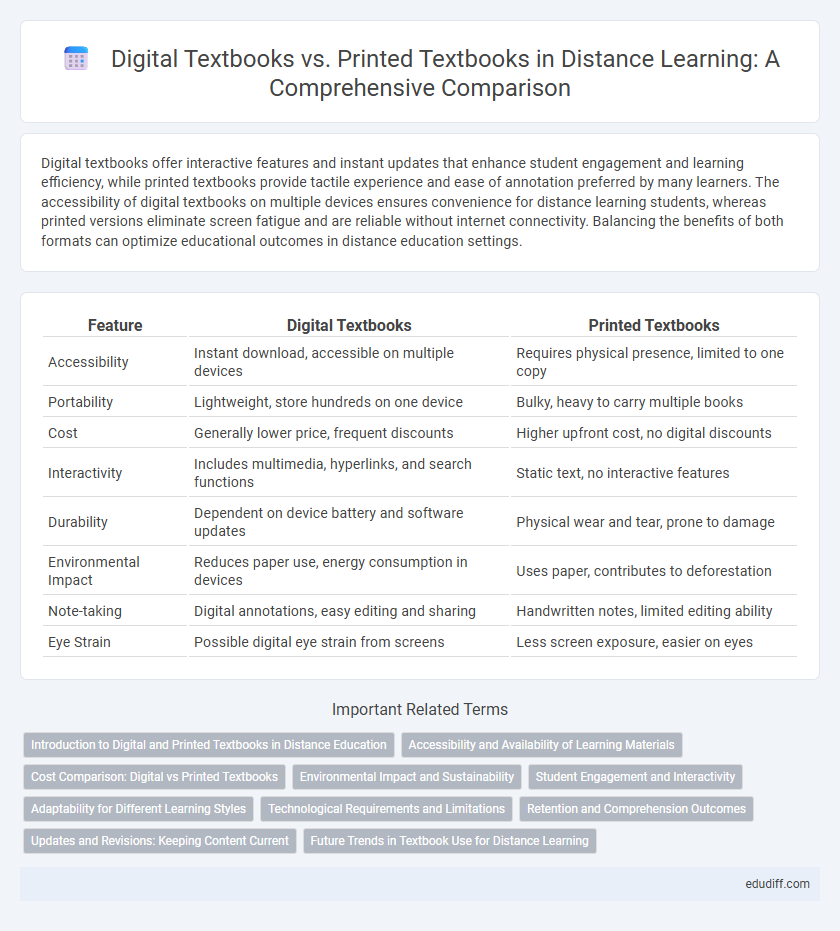Digital textbooks offer interactive features and instant updates that enhance student engagement and learning efficiency, while printed textbooks provide tactile experience and ease of annotation preferred by many learners. The accessibility of digital textbooks on multiple devices ensures convenience for distance learning students, whereas printed versions eliminate screen fatigue and are reliable without internet connectivity. Balancing the benefits of both formats can optimize educational outcomes in distance education settings.
Table of Comparison
| Feature | Digital Textbooks | Printed Textbooks |
|---|---|---|
| Accessibility | Instant download, accessible on multiple devices | Requires physical presence, limited to one copy |
| Portability | Lightweight, store hundreds on one device | Bulky, heavy to carry multiple books |
| Cost | Generally lower price, frequent discounts | Higher upfront cost, no digital discounts |
| Interactivity | Includes multimedia, hyperlinks, and search functions | Static text, no interactive features |
| Durability | Dependent on device battery and software updates | Physical wear and tear, prone to damage |
| Environmental Impact | Reduces paper use, energy consumption in devices | Uses paper, contributes to deforestation |
| Note-taking | Digital annotations, easy editing and sharing | Handwritten notes, limited editing ability |
| Eye Strain | Possible digital eye strain from screens | Less screen exposure, easier on eyes |
Introduction to Digital and Printed Textbooks in Distance Education
Digital textbooks enhance distance education by providing instant access to interactive content, multimedia resources, and real-time updates that adapt to diverse learning needs. Printed textbooks offer tangible, distraction-free reading experiences and ease of annotation, fostering deep comprehension for students studying remotely. Both formats contribute uniquely to distance learning environments, supporting varied learner preferences and logistical challenges.
Accessibility and Availability of Learning Materials
Digital textbooks offer unprecedented accessibility, allowing students to access learning materials anytime and anywhere with an internet connection, which is especially beneficial for distance education. Printed textbooks, while sometimes limited by geographic availability and shipping delays, provide a reliable resource that requires no electronic devices or connectivity. The availability of digital formats supports diverse learning needs through adjustable text sizes and built-in search functions, enhancing usability across different learning environments.
Cost Comparison: Digital vs Printed Textbooks
Digital textbooks typically offer a lower upfront cost compared to printed textbooks, often priced 30-50% less due to reduced production and distribution expenses. Savings on physical storage and potential for bulk licensing discounts further enhance affordability in educational institutions. However, access to compatible devices and potential subscription fees may influence the overall cost-effectiveness for some users.
Environmental Impact and Sustainability
Digital textbooks significantly reduce paper consumption and deforestation, leading to lower carbon emissions compared to printed textbooks. The production and disposal of printed textbooks contribute to landfill waste and chemical pollution from ink and binding materials. Transitioning to digital textbooks supports sustainability by minimizing resource extraction and promoting energy-efficient content distribution.
Student Engagement and Interactivity
Digital textbooks enhance student engagement through interactive features such as embedded quizzes, multimedia content, and real-time feedback, promoting active participation and personalized learning. Printed textbooks, while tangible and distraction-free, lack dynamic interactivity and often result in passive reading experiences. The integration of adaptive learning technologies in digital formats significantly improves comprehension and retention by catering to diverse learning styles.
Adaptability for Different Learning Styles
Digital textbooks offer customizable features such as adjustable font sizes, interactive multimedia, and embedded quizzes, accommodating visual, auditory, and kinesthetic learners more effectively than printed textbooks. Printed textbooks provide tangible, consistent layouts that benefit readers who prefer tactile engagement and minimal screen exposure. Adaptability for different learning styles is enhanced in digital formats through personalized content delivery and instant feedback mechanisms.
Technological Requirements and Limitations
Digital textbooks require reliable internet access and compatible devices like tablets, laptops, or e-readers, which can limit accessibility in remote or underdeveloped areas. Printed textbooks, while free from technological dependencies, involve logistical challenges such as physical storage, transportation, and wear over time. The reliance on technology for digital formats also raises concerns about screen fatigue and the need for regular software updates to ensure usability.
Retention and Comprehension Outcomes
Studies indicate that printed textbooks often enhance retention and comprehension more effectively than digital textbooks due to reduced screen fatigue and fewer distractions. Research from the Journal of Educational Psychology shows students retain 15-20% more information from printed materials. Moreover, tactile engagement with physical books supports cognitive mapping, which improves the understanding and long-term recall of complex concepts.
Updates and Revisions: Keeping Content Current
Digital textbooks enable instant updates and revisions, ensuring that content reflects the latest information and research without delay. Printed textbooks require new editions for updates, often resulting in outdated material during the revision cycle. Real-time content management in digital formats enhances accuracy and relevance in educational resources.
Future Trends in Textbook Use for Distance Learning
Digital textbooks are rapidly becoming the preferred choice for distance learning due to their interactive features, real-time updates, and accessibility across multiple devices. Innovations such as AI-driven content personalization and augmented reality are enhancing student engagement and comprehension. Future trends indicate a shift toward fully integrated digital ecosystems that combine adaptive learning technologies with cloud-based resources to support flexible, remote education.
Digital textbooks vs Printed textbooks Infographic

 edudiff.com
edudiff.com